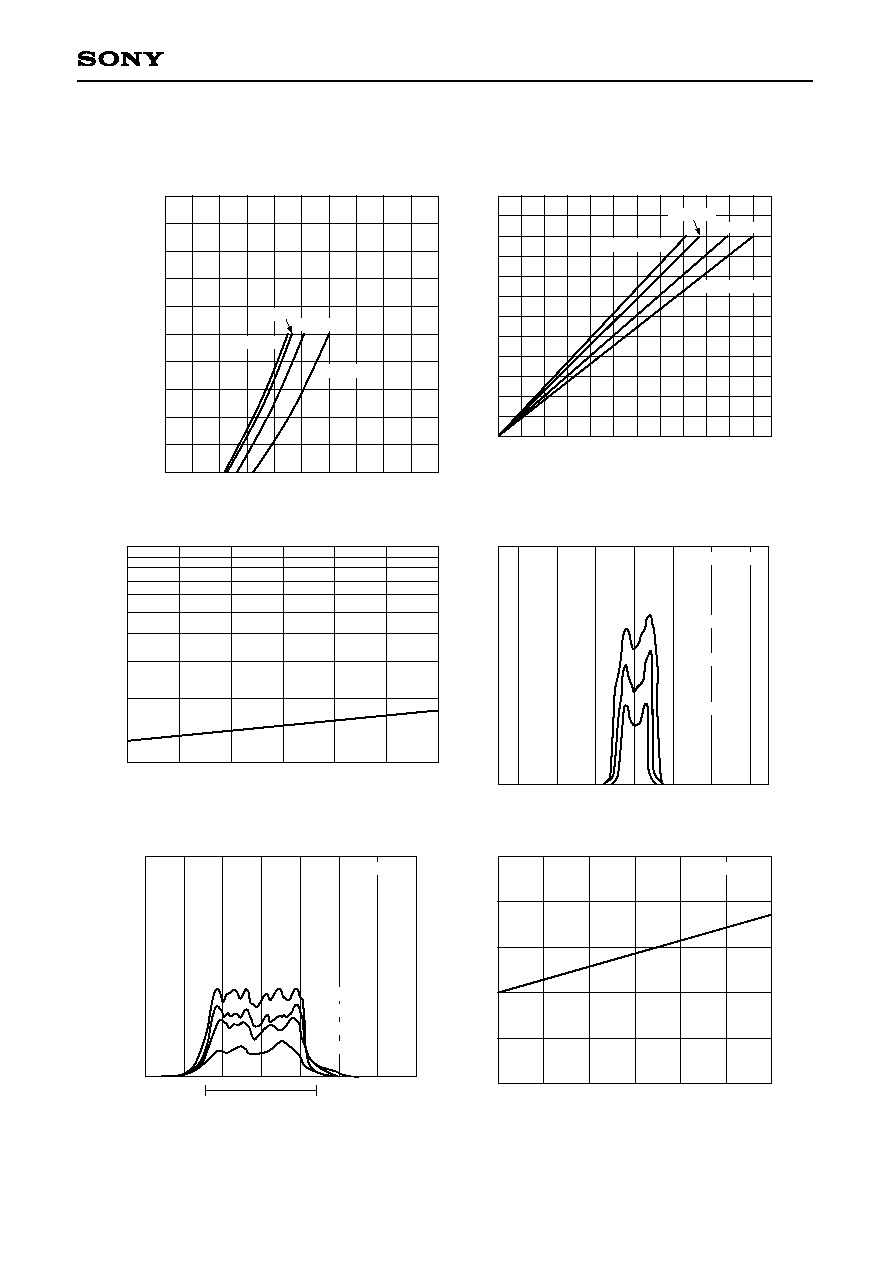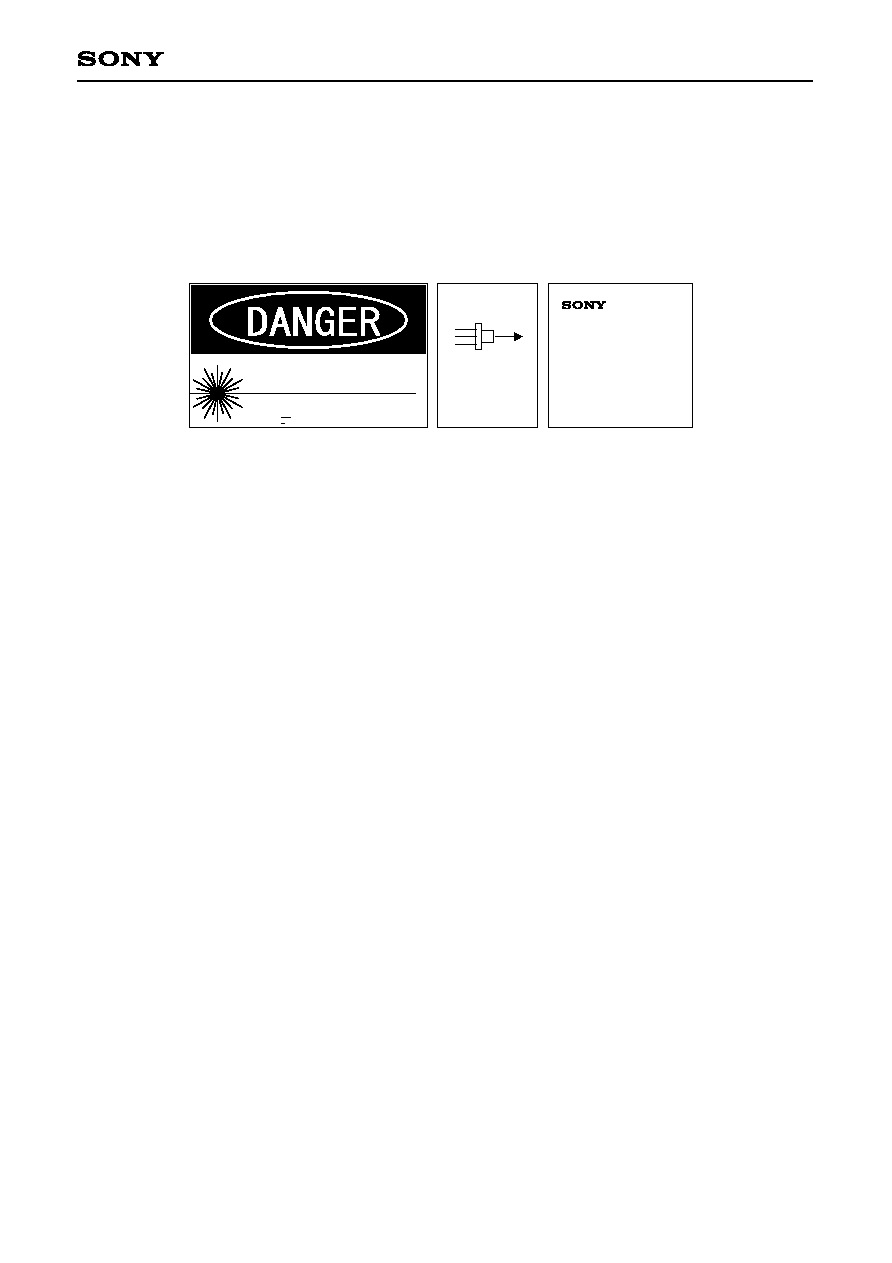 | –≠–ª–µ–∫—Ç—Ä–æ–Ω–Ω—ã–π –∫–æ–º–ø–æ–Ω–µ–Ω—Ç: SLD301V-2 | –°–∫–∞—á–∞—Ç—å:  PDF PDF  ZIP ZIP |

100mW High Power Laser Diode
Description
The SLD301V is a gain-guided, high-power laser
diode fabricated by MOCVD.
MOCVD: Metal Organic Chemical Vapor Deposition
Features
∑ High power
Recommended power output Po = 90mW
∑ Low operating current
Applications
∑ Solid state laser excitation
∑ Medical use
Structure
GaAlAs double-hetero-type laser diode
Operating Lifetime
MTTF 10,000H (effective value) at Po = 90mW, Tc = 25∞C
Absolute Maximum Ratings (Tc = 25∞C)
∑ Optical power output
Pomax
100
mW
∑ Reverse voltage
V
R
LD
2
V
PD
15
V
∑ Operating temperature Topr
≠10 to +50
∞C
∑ Storage temperature
Tstg
≠40 to +85
∞C
Warranty
This warranty period shall be 90 days after receipt of
the product or 1,000 hours operation time whichever
is shorter.
Sony Quality Assurance Department shall analyze
any product that fails during said warranty period,
and if the analysis results show that the product
failed due to material or manufacturing defects on the
part of Sony, the product shall be replaced free of
charge.
Laser diodes naturally have differing lifetimes which
follow a Weibull distribution.
Special warranties are also available.
≠ 1 ≠
E88057I19-PS
Sony reserves the right to change products and specifications without prior notice. This information does not convey any license by
any implication or otherwise under any patents or other right. Application circuits shown, if any, are typical examples illustrating the
operation of the devices. Sony cannot assume responsibility for any problems arising out of the use of these circuits.
SLD301V
2
Bottom View
1. LD cathode
2. PD anode
3. COMMON
1
3
Pin Configuration
M-248

≠ 2 ≠
SLD301V
Electrical and Optical Characteristics
(Tc: Case temperature, Tc = 25∞C)
Item
Symbol
Conditions
Min.
Typ.
Max.
Unit
Ith
Iop
Vop
p
Imon
//
X,
Y
D
Threshold current
Operating current
Operating voltage
Wavelength
1
Monitor current
Radiation angle
(F. W. H. M.
)
Positional accuracy
Differential efficiency
P
O
= 90mW
P
O
= 90mW
P
O
= 90mW
P
O
= 90mW
V
R
= 10V
P
O
= 90mW
P
O
= 90mW
P
O
= 90mW
770
0.65
150
250
1.9
0.15
28
12
0.9
200
400
3.0
840
40
17
±50
±3
mA
mA
V
nm
mA
degree
degree
µm
degree
mW/mA
Perpendicular
Parallel
Position
Angle
1
Wavelength Selection Classification
Type
SLD301V-1
SLD301V-2
SLD301V-3
Wavelength (nm)
785 ± 15
810 ± 10
830 ± 10
Type
SLD301V-21
SLD301V-24
SLD301V-25
Wavelength (nm)
798 ± 3
807 ± 3
810 ± 3
F. W. H. M. : Full Width at Half Maximum

≠ 3 ≠
SLD301V
Example of Representative Characteristics
Optical power output vs.
Forward current characteristics
I
F
≠ Forward current [mA]
0
250
500
0
100
200
Po
≠
Optical power output [mW]
T
C
= ≠10
∞
C
T
C
= 0
∞
C
T
C
= 25
∞
C
T
C
= 50
∞
C
Optical power output vs. Monitor current characteristics
Imon ≠ Monitor current [mA]
0
0.05
0.1
0
50
100
Po
≠
Optical power output [mW]
T
C
= ≠10
∞
C
T
C
= 0
∞
C
T
C
= 25
∞
C
T
C
= 50
∞
C
Threshold current vs. Temperature characteristics
Tc ≠ Case temperature [
∞
C]
≠10
0
10
20
30
40
50
100
500
1000
Ith
≠
Threshold current [mA]
Power dependence of far field pattern
(parallel to junction)
Angle [degree]
≠30
≠20
≠10
0
10
20
30
Radiation intensity (optional scale)
T
C
= 25
∞
C
P
O
= 90mW
P
O
= 60mW
P
O
= 30mW
Power depecdence of near field pattern
50
µ
m
Radiation intensity (optional scale)
T
C
= 25
∞
C
P
O
= 90mW
P
O
= 75mW
P
O
= 50mW
P
O
= 25mW
Oscillation wavelength vs. Temperature characteristics
Tc ≠ Case temperature [
∞
C]
≠10
0
10
20
30
40
50
780
790
830
820
810
800
p
≠
Oscillation wavelength [nm]
P
O
= 90mW

≠ 4 ≠
SLD301V
Differential efficiency vs. Temperature characteristics
Tc ≠ Case temperature [
∞
C]
≠10
0
50
40
30
20
10
0
0.5
1.0
1.5
D
≠
Dif
ferential ef
ficiency [mW/mA]
Power dependence of polarization ratio
Po ≠ Optical power output [mW]
0
20
40
60
80
100
120
0
10
30
20
40
Polarization ratio
Tc = 25
∞
C

≠ 5 ≠
SLD301V
Wavelength [nm]
800
810
805
Relativ
e r
adiant intensity
Tc = 25
∞
C
Po = 20mW
Wavelength [nm]
800
810
805
Relativ
e r
adiant intensity
Tc = 25
∞
C
Po = 40mW
Wavelength [nm]
800
810
805
Relativ
e r
adiant intensity
Tc = 25
∞
C
Po = 80mW
Wavelength [nm]
800
810
805
Relativ
e r
adiant intensity
Tc = 25
∞
C
Po = 100mW
Wavelength [nm]
800
810
805
Relativ
e r
adiant intensity
Tc = 25
∞
C
Po = 60mW
Power dependence of wavelength (Spectrum)

≠ 6 ≠
SLD301V
Wavelength [nm]
805
825
815
Relativ
e r
adiant intensity
Tc = ≠6
∞
C
Wavelength [nm]
805
825
815
Relativ
e r
adiant intensity
Tc = 12
∞
C
Wavelength [nm]
805
825
815
Relativ
e r
adiant intensity
Tc = 23
∞
C
Wavelength [nm]
805
825
815
Relativ
e r
adiant intensity
Tc = 35
∞
C
Wavelength [nm]
805
825
815
Relativ
e r
adiant intensity
Tc = 45
∞
C
Temperature dependence of wavelength (Po = 90mW)

≠ 7 ≠
SLD301V
Notes on Operation
Care should be taken for the following points when using this product.
(1) This product corresponds to a Class 4 product under IEC60825-1 and JIS standard C6802 "Laser Product
Emission Safety Standards".
(2) Eye protection against laser beams
Take care not to allow laser beams to enter your eyes under any circumstances.
For observing laser beams, ALWAYS use safety goggles that block laser beams. Usage of IR scopes, IR
cameras and fluorescent plates is also recommended for monitoring laser beams safely.
(3) Gallium Arsenide
This product uses gallium arsenide (GaAs). This is not a problem for normal use, but GaAs vapors may be
potentially hazardous to the human body. Therefore, never crush, heat to the maximum storage temperature
or higher, or place the product in your mouth.
In addition, the following disposal methods are recommended when disposing of this product.
1. Engaging the services of a contractor certified in the collection, transport and intermediate treatment
of items containing arsenic.
2. Managing the product through to final disposal as specially managed industrial waste which is
handled separately from general industrial waste and household waste.
(4) Prevention of surge current and electrostatic discharge
Laser diodes are most sensitive to electrostatic discharge among semiconductors. When a large current is
passed through the laser diode for even an extremely short time, the strong light emitted from the laser
diode promotes deterioration and then destruction of the laser diode. Therefore, note that surge current
should not flow to the laser diode driving circuit from switches and others. Also, if the laser diode is
handled carelessly, it may be destroyed instantly because electrostatic discharge is easily applied by a
human body. Therefore, be extremely careful about overcurrent and electrostatic discharge.
(5) Use for special applications
This product is not designed or manufactured for use in equipment used under circumstances where
failure may pose a risk to life and limb, or result in significant material damage, etc.
Consult your Sony sales representative when investigating use for medical, vehicle, nuclear power control
or other special applications. Also, use the power supply that was designed not to exceed the optical
power output specified at the absolute maximum ratings.
LASER RADIATION
AVOID EYE OR SKIN EXPOSURE TO
DIRECT OR SCATTERED RADIATION
LASER DIODE
LASER DIODE
AVOID EXPOSURE
Laser radiation is
emitted from this
aperture.
This product complies with 21
CFR Part 1040.10 and 1040.11
Sony Corporation
6-7-35 Kitashinagawa,
Shinagawa-ku,Tokyo
141-0001 Japan
MAXIMUM OUTPUT
OVER 1 W
WAVELENGTH
600 - 950 nm
CLASS IV LASER PRODUCT

≠ 8 ≠
SLD301V
Package Outline
Unit: mm
M-248 (LO-11)
Reference
Slot
1.0
0.4
Photo
Diode
2
3
1
Window
Glass
Reference
Plane
LD Chip
9.0 ≠ 0.015
0
7.7 MAX
6.9 MAX
3.5
0.6 MAX
2.45
3.4 MAX
1.5
7.0 MAX
3 ≠
0.45
PCD
2.54
Optical
Distance = 2.55 ± 0.05
SONY CODE
EIAJ CODE
JEDEC CODE
M-248
PACKAGE MASS
1.2g
Sony Corporation







